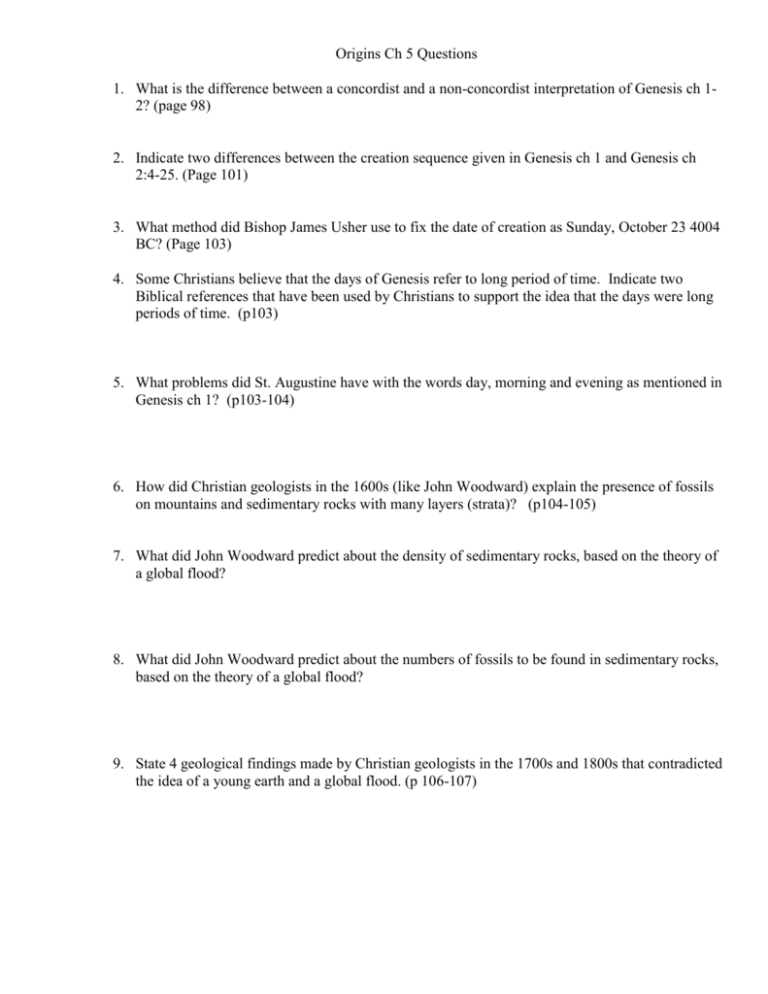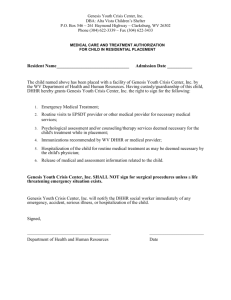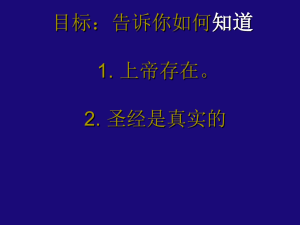5.2 Chapter 5 Questions
advertisement

Origins Ch 5 Questions 1. What is the difference between a concordist and a non-concordist interpretation of Genesis ch 12? (page 98) 2. Indicate two differences between the creation sequence given in Genesis ch 1 and Genesis ch 2:4-25. (Page 101) 3. What method did Bishop James Usher use to fix the date of creation as Sunday, October 23 4004 BC? (Page 103) 4. Some Christians believe that the days of Genesis refer to long period of time. Indicate two Biblical references that have been used by Christians to support the idea that the days were long periods of time. (p103) 5. What problems did St. Augustine have with the words day, morning and evening as mentioned in Genesis ch 1? (p103-104) 6. How did Christian geologists in the 1600s (like John Woodward) explain the presence of fossils on mountains and sedimentary rocks with many layers (strata)? (p104-105) 7. What did John Woodward predict about the density of sedimentary rocks, based on the theory of a global flood? 8. What did John Woodward predict about the numbers of fossils to be found in sedimentary rocks, based on the theory of a global flood? 9. State 4 geological findings made by Christian geologists in the 1700s and 1800s that contradicted the idea of a young earth and a global flood. (p 106-107) Origins Ch 5 Questions 10. How did Christian geologists in the 1700s and 1800s respond to the contradictions they were finding in God’s book of Nature about the apparent old age of the earth compared to the Genesis interpretation that the Bible taught that the earth was young? (p107-108) 11. What was it that caused Christians to look at new interpretations of Genesis ch 1 like the Gap interpretation, the Day-Age interpretation, the Appearance of Age interpretation? (p 108, 2nd to last paragraph) 12. How does the Gap interpretation of Genesis ch1 explain the apparent old age of the earth? (p109) 13. Indicate two problems the Gap interpretation has. (p109) 14. How does the Day-Age interpretation of Genesis ch1 explain the apparent old age of the earth? (p110) 15. What are two arguments made to support the Day-Age interpretation? (p110) 16. What problem does the Day-Age interpretation have in terms of the sequence found in Genesis ch 1 and the sequence of fossils found in geologic strata? (p110-111) Origins Ch 5 Questions 17. In the sequence in Genesis ch 1, plants are created before the sun. For the Day-Age interpretation, what are some of the problems with seed-bearing plants and fruit trees being created millions of years (day-age three) before the sun (day-age 4) and animals (day-age 5 and 6)? (p112) 18. How does the Appearance of Age interpretation avoid the conflict between the apparent old age of the earth and the Genesis ch 1 account (understood in a mostly literal way)? (p112) 19. What theological problem does the Appearance of Age interpretation have? (p112-113) 20. How does continental drift provide evidence for an old earth? (p115-116) 21. How does glacier ice layering provide evidence for an old earth? (p116) 22. How many radiometric dating techniques are used to date earth rocks? (p117) 23. Give an example of radiometric dating providing evidence for an old earth. (p117) Origins Ch 5 Questions 24. What are four predictions that young earth creationists (Creation Science Group) make regarding the geology of the earth? (p118) 25. According to the Creation Science Group, teachings like communism, racism, humanism etc. are all basing themselves or relying on what teachings? (quote p119) 26. What was the response of the scientific community when John Eddy and Aram Boornazian reported that the sun was shrinking? (p120-122) 27. What was the response of Creation scientist, Russell Ackridge, to the shrinking sun report of Eddy and Boornazian? (p122) 28. What are two problems with Ackridge’s article, “The Sun is Shrinking”? (p122) 29. The shrinking sun argument for a young earth illustrates one problem that occurs frequently with the Creation science group and their publications. What is this problem? (p123) 30. What are some other questionable practices used by some Creation science proponents? (p123) Origins Ch 5 Questions 31. What are some signs that a scientific argument is strong? 32. What are some signs that a scientific argument is speculative? 33. What are some signs that a scientific argument is fundamentally flawed?







